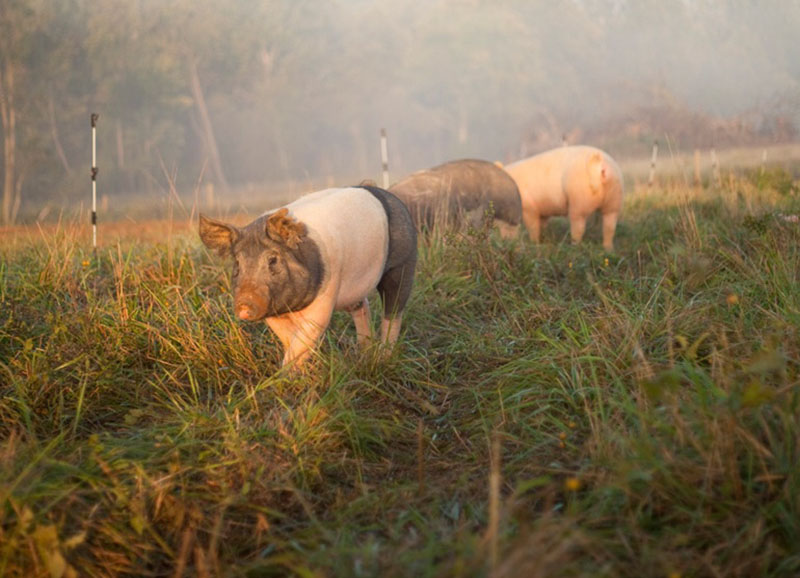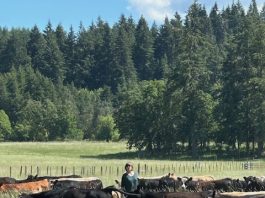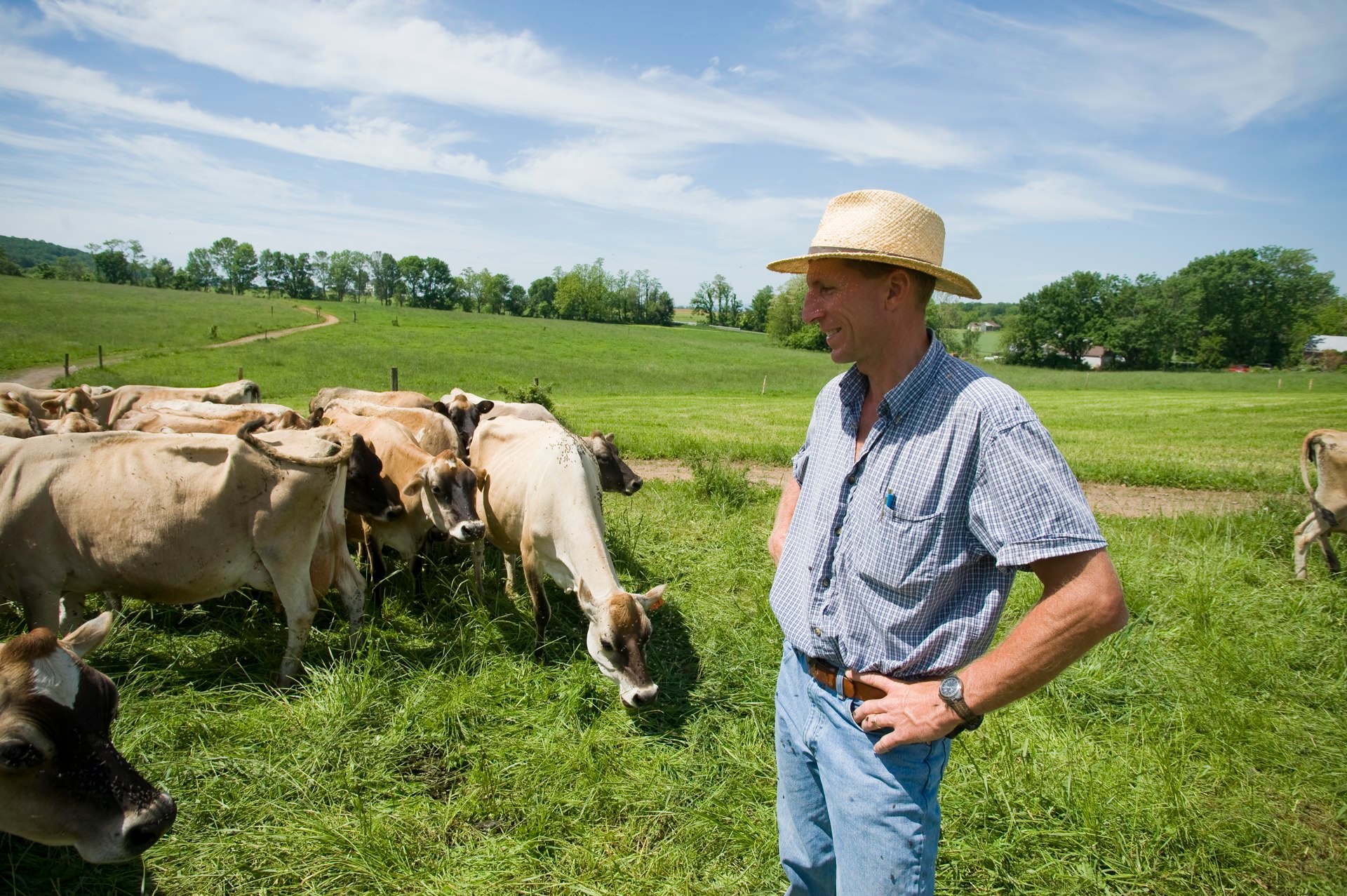
Pasturing pigs isn’t a new idea. In fact, hogs have been raised in American meadows and woodlots since our country’s inception. Long before confinement barns, farrowing crates and manure lagoons became industry norms, pastured pigs were raised and finished on grass from coast to coast. From the A-frame pasture sleds of the Midwest to the oak-rich mountains of Appalachia, free-range pork has long been a brushstroke on our agricultural landscape.
My own grandfather, who considered swine an afterthought to his primary orchard and cattle business, took time to turn hogs loose amongst his apple trees from fall to spring. They gleaned fallen fruit, rooted up mouse nests, and fertilized the soil, all for pennies on the dollar. On a diversified farm, raising free-range hogs makes sense and cents.
Despite a rich tradition of pastured pig husbandry, a generation of experience and know-how was lost during the second half of the 20th century. As producers abandoned traditional outdoor systems and embraced confinement hog buildings, decades of hard-won wisdom quietly slipped through our fingers. When I began farming full-time in the mid 1990s, information about free-range pig systems at that time amounted to a few paragraphs in How To livestock books, or imaginative applications such as Polyface’s now famous Pigaerator Pork.
But I needed a system that accounted for seasonality and scaleability, combining modern efficiencies with old-fashioned husbandry practices. I wanted a better understanding of how pigs might fertilize depleted soils and interact with other livestock species, all the while producing mouth-watering bacon and hams. In hindsight, I’m not sure these restoration philosophies existed in one place. In an attempt to remedy this, here’s a list I wish had been available when I started out, knowledge I’ve gained from raising pastured stocker pigs for over fifteen years.
Quick note: This article is intended for successfully raising stockers on pasture, not farrowing sows. That’s a topic for a different article.
Raising Pigs on Pasture: An Evolution
Version 1.0
Everyone has to start somewhere, and our farm is no different. During my first attempt at raising pastured pigs, I turned loose a group of twenty 50 pound piglets onto 15 acres. From the first moment they stepped off the trailer these pigs were in hog heaven, rooting the ground, grazing lush legumes and napping contentedly beneath our scattered shade trees. We gave them unrestricted access to feed, water and forage, and things went so well that a month later I purchased 20 more, then 20 more again. Before I knew it, I was the owner of 60 healthy, frolicking pigs running hither and yon, all different colors, sizes and personalities. Aside from checking on their daily feed and water, the pigs pretty much took care of themselves. I’ve dubbed this scenario “Pastured Pigs, version 1.0”.

It was all rainbows and butterflies for a few months, but the trouble began soon thereafter. Because pigs don’t sweat, they created large wallows to cool off. While at first I found this habit to be entertaining (and endearing), I commonly observed hogs drinking from this muddy, contaminated water. Hogwash, I said, and I was right. Widespread diarrhea quickly followed, accompanied by weight loss. The green water in these puddles looked as inviting as a neglected kiddie pool in late September.
Meanwhile, the pigs continued to root the pasture, constantly worrying the soil beyond its capacity to reestablish itself. After a few months of non-stop snout activity, my pasture effectively became a moonscape, pocked here and there with rank, algae-rimmed wallows. As a consequence, the pigs now relied almost exclusively on their grain ration, and manured straight onto bare, unvegetated ground. In effect, I had unintentionally allowed the pigs to create their own feedlot, the very thing I was seeking to avoid. I knew the system had to change, for the benefit of the soil as well as the hogs.
Version 2.0

In version 2.0, I’ve noticed a hot trend of raising hogs in woodlots and forests, and finishing the hogs on mast (nuts). While this sounds practical on paper, many of the same drawbacks found in version 1.0 also exist in 2.0 without careful oversight. Just like on open pasture, hogs will create a barren feed-lot landscape after a month or so if not rotated. This problem becomes compounded in a forest, however, because the delicate soil structure beneath the tree canopy is largely comprised of leaf litter, not widely vegetation. Combined with an inclined gradient, this is a sure recipe for extreme erosion during a significant rainfall.
For version 2.0 to be successful (and it certainly can be), it’s my belief that acorn finishing should be an SEASONAL component of a free-range system, not a primary platform. The floor of a forest is armored with leaves for a reason; rain gently glazes off the durable litter, and water is distributed at an appropriate rate. Once this protection is heavily bioturbated by pig snouts, even a half-inch of rain can have disastrous effects.

Remember: gravity causes nutrients to flow DOWNhill. If we’re going to import nutrients UPhill—via pig manure—then we must do it strategically. This is accomplished by 1) patiently waiting for a seasonal nutfall to occur (mysteriously, sometimes this doesn’t happen for several years), 2) rotating the hogs through polywire forested alleys every week or two, and 3) getting them out again. When managed well, acorn-fed pork can be a tremendously efficient—and delicious—way to raise pigs.
Version 3.0
Several years ago at my farm Smith Meadows, we arrived at version 3.0. It’s a system intended to maximize soil building, multi-species grazing and authentic free-ranging for our pigs. Known as a ‘pivot system’, each field is envisioned like an old-fashion wagon wheel: a hub in the center, with spokes extending to the perimeter. In our case, the ‘wheel’ just happens to be a square field.

We start with 15 acres of permanent perimeter fence, then identify high ground as close to the center of the field as possible. This is our dedicated ‘sacrifice area,’ where our infrastructure is placed for precisely one year. It’s comprised of several large hog shelters (we use the evocatively named brand ‘Port-A-Hut’), and a fixed automatic waterer. High ground is important here because throughout the course of one year we commonly receive 35-40 inches of rainfall, and this water needs to drain away from the sacrifice area. Otherwise, the area can quickly become bogged down in muck.
Next, we pace off the perimeter, and divide it by 26. Fifty two weeks divided by twenty six means every two weeks the pigs receive a fresh rotation of one half acre. We typically stock 50 to 60 hogs at a time (of various sizes depending on what our breeders have available) and over the course of the year finish 250 hogs at roughly two hundred and sixty five pounds slaughter weight. In short, we’re growing 250 hogs a year on 15 acres, with next to no reseeding and very little labor. All the while, we our perennial pastures remain more or less intact for our sheep and cattle.

When provided with fresh pasture, pigs will actively graze. This reduces grain requirements, and distracts them from aggressive rooting. Of course, pigs WILL root a good bit of the pasture. But the key is to rotate them precisely every two weeks, and allow the pasture to rest and recover. As long as it is no longer disturbed, rooted pasture will mostly re-root itself and continue to grow. Between the hog manure fertilizer and the newly available seed bank, pasture recovers after a month or so with adequate rainfall (3/4 inch per week). If you live in a part of the country where this sort of rainfall is unlikely, then consider rotating one every week.
Gravity feeders are placed at the end of each run to encourage exercise, as well as manure dispersal. The hogs are fed a non-GMO blend of barley and wheat rated at 12% protein. When empty, these feeders are simply tipped onto their side and rolled to the new location. We use a single strand of polywire with a hot reading of 4.0 to control the hogs. The wire is strung about mid calf-height (or just below the knee), and step-in posts are spaced about 30 feet apart. A typical rotation takes 2 people about 45 minutes every two weeks.
For our waterer, we use an 85 gallon poly tank with a float in the bottom. We install a second float in the top to control flow from the inlet hose. This is placed on a raised platform of pressure treated boards, and backfilled with gravel. The raised platform and gravel are intended to keep the splashed-out water from becoming a wallow. (The shelters provide them with plenty of shade and air flow to keep them cool in the summer). We use a hangman-type scaffolding to carry the piping over the hot wire and into the water tank. Otherwise, the pigs will chew the pipe to the point of breaking.

The shelters are continually deep bedded with straw, which keeps the hogs warm on cold nights, and reduces floor moisture. However, as a result of rain shedding off the roofs, areas directly adjacent to the shelters are especially prone to puddling, followed by hog wallows. I can’t overemphasize how important it is to keep wallowing to a minimum, as it will reduce parasite loads and intestinal trouble down the road. Take my word for it: a sick pig is an unhappy pig. Good farmers raise happy pigs.
Lastly, to train our new hogs we create a miniature hub directly adjacent to the primary hub (visible on the left of the adjacent photo). This is a 32×32 foot area, cordoned off with cattle panels with a hot polytape running just inside the enclosure. This allows the young pigs to learn about the wire, without breaking out, knocking down posts and destroying wire. They learn quickly not to touch the wire! We leave them in here for 48 hours, and when turned out, we rarely have problems with them respecting the fence.
☀ ☀ ☀

This is the evolution of pastured pigs on my farm thus far, and I’m sure there will be many more improvements along the way (in the coming year, we’re experimenting with more efficient ways to store and feed grain). For success, rotation and nutrient management are the key. As free-range hog producers, collectively we can put the days of pigs wallowing in mucky pastures into our rear-view mirror. Let’s move forward with soil health, contented animals, and long term profitability.
Please share your comments, experiences and innovations below!







Thank you very much for your article. My son is actively involved in the 4-H Market Hog project, and he has been interested in starting a small pasture based operation to meet the demand in our area for pasture pork. I look forward to checking out your web site. If you’re on twitter you can follow us at @4HMan
What a pleasant surprise on Sunday. I went into our church library,
White Plains UMC in Cary, NC and was browsing the shelves..and there you were…was happy to see that someone had bought your book for our church. Don’t know who suggested it, but am anxious to find out.
Steve and I have a copy, but I have yet to read it. It is definitely on my soon to read schedule.
Wishing you and your family well.
Connie Barron Washburn (from Shepherdstown)
Hi Forrest,
This was a very informative article, thank you. Am I understanding you correctly that you do not allow your pigs to dig wallows in your most recent iteration?
I’m getting some pigs this year for the first time, and I’ve been led to beleive that they need to be able to get mud on their skin for heat/sun/insect protection. But it sounds like you take steps to prevent wallowing, and you’re in a hotter part of the country than I am (in NY).
Thanks,
Edmund
We do something similar but with about a decade’s more refinement. We use managed rotational grazing with our pigs. We learned it on sheep decades ago and the same basic principles apply to pigs, chickens and other animals. The result is gradual improvement in our soils and our pigs get the vast majority of their feed from pasture – we buy no commercial hog feed or grains but are able to raise about 400 pigs this way, breeding through farrowing to finish delivering weekly to area stores and restaurants as well as individuals. Once you get the kinks worked out and things smooth it’s a matter of rinse and repeat with gradual refinements over the years.
One other thing we do is our sacrificial area is our winter paddocks – for the months on end when we’re up high on snow pack. During the warm season we grow acres of pumpkins, sunflowers, beets, turnips and other crops there which become fall and winter food for our livestock. They do the fertilizing and weeding as well as harvesting. We just have to plant and fence.
Walter, this sounds amazing, and exactly how I’d imagine a version 4.0 (or beyond) taking shape. Would love to know more. Where are you located, and do you have a website I can check out?
Okay, found you up in Vermont! The next time I’m up that way, can I come visit your place?
Hi Forrest,
We are up in the mountains of central Vermont. We don’t do physical visits for biosecurity reasons (read up on PEDv) since we have multiple genetic lines we need to protect. But the good news I have an extensive blog at http://SugarMtnFarm.com with about 2,000 articles on it that goes into quite a bit of detail about how we do things including pasturing pigs using managed rotational grazing, dealing with winter in our deep snow climate, support staff like chickens, etc. That virtual visitation is actually better than a physical visit because you can see our farm over a period of the past nine years through all five seasons of the year.
On the wallows, they are important during hot weather, as is shade, of course. Mud helps with temperature regulation, skin protection from the sun, insects and is good for beauty makeovers – so say the pigs. Here in the winter the wallows aren’t used. Like with pastures, our wallows get rotation although not as much as pasture gets as there are some central wallows that get shared by several pastures. Due to our cold season though they get rotated off much of the year as they’re frozen solid and buried beneath deep snow in winter.
Keep on fine tuning your systems, go for 4.0, 5.0, etc. Keep observing and incrementally improving things. What works for one person will give others ideas but often needs localization to adjust for differences in climate, genetics, forages, etc.
Cheers,
-Walter Jeffries
Sugar Mountain Farm
in the mountains of Vermont
It would be great to get in touch with you
We started heritage pasture pigs and do multy spices intensive rotational grazing to rehabilitate pasture and build soil.
Thanks Bill. Indeed, we get our share of snow in the Shenandoah Valley, often arriving in the form of 8-12 inches a clip. Having the pigs trained to walk to the feeders is especially useful during snowstorms, as they can readily break a trail in snow as deep as 2 feet. The real benefit comes after the snow melt, as hoof traffic remains spread out during boggy, semi-frozen conditions. Every little trick helps, keeping that pasture robust for spring green up.
Excellent article! I’m curious to know what your winter weather is like. Do you ever have pigs on snow or even deep snow? thanks, Bill
Comments are closed.